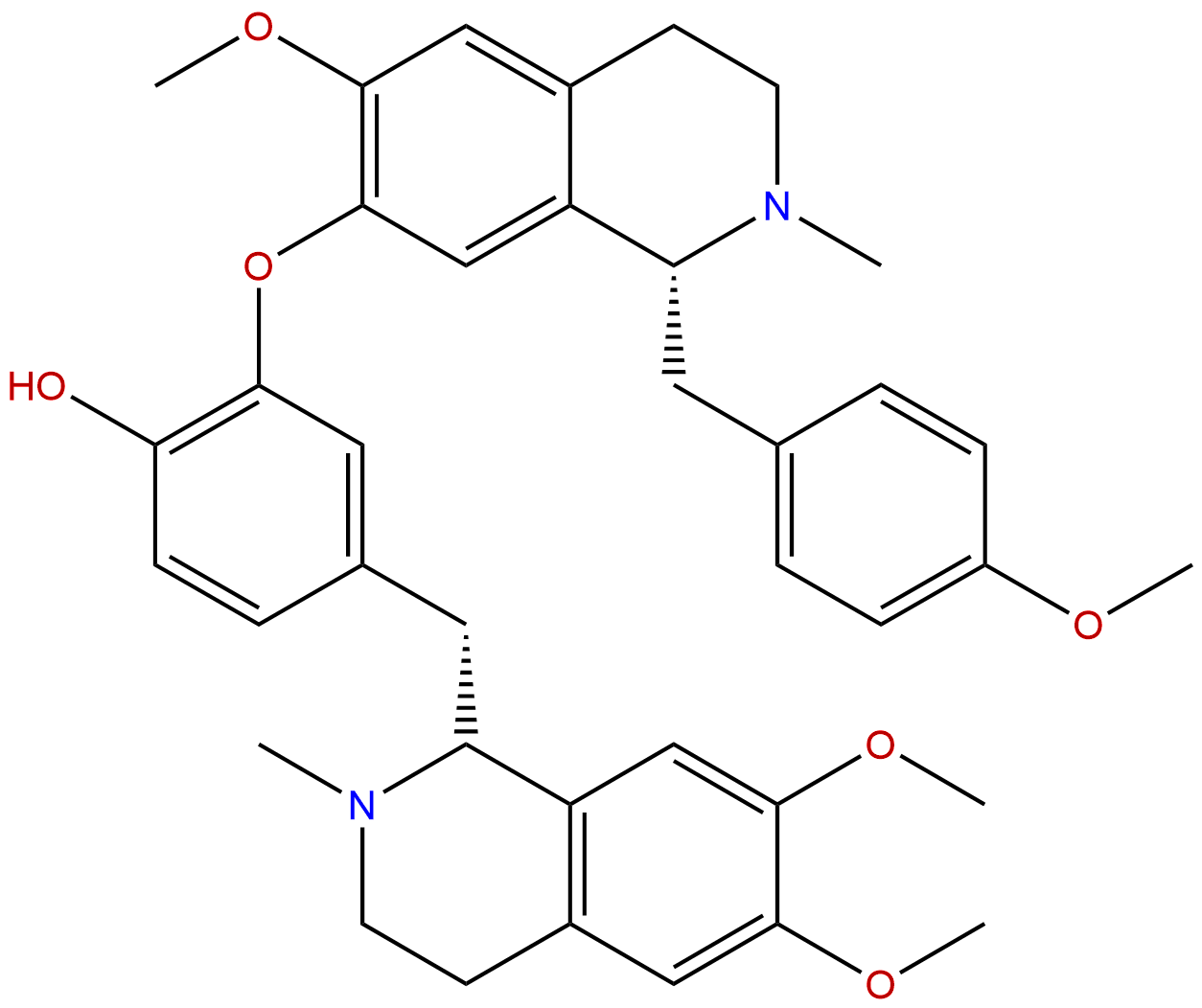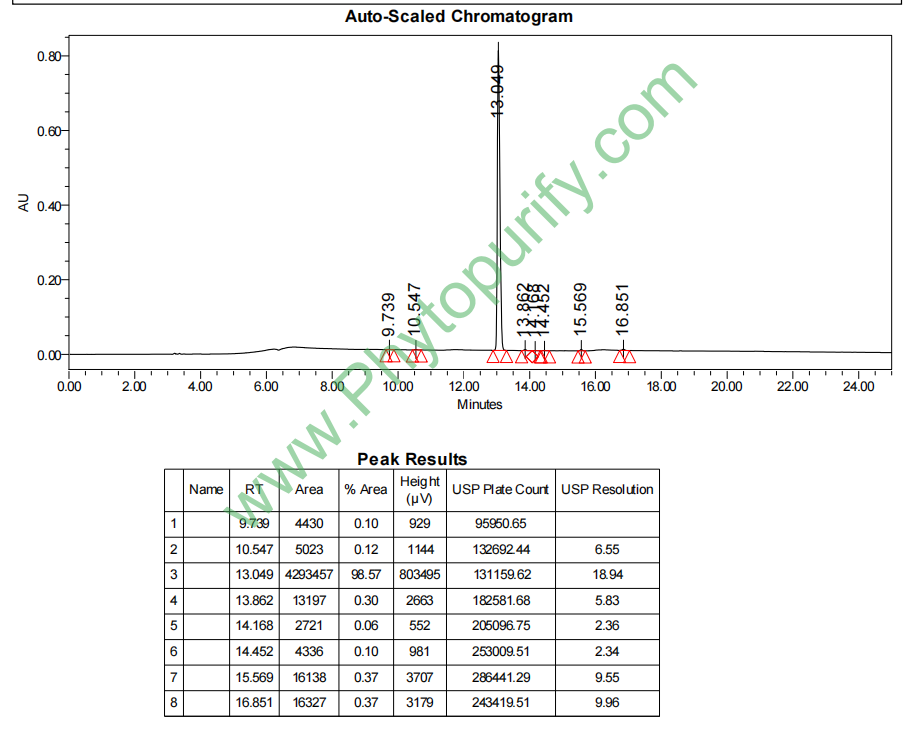
NeferineCAS No.:2292-16-2
|
||||||||||
 |
|
|
||||||||

| Catalogue No.: | BP0987 |
| Formula: | C38H44N2O6 |
| Mol Weight: | 624.778 |
Product name: Neferine
Synonym name: 4''-O-Methylliensinine; Methylliensinine
Catalogue No.: BP0987
Cas No.: 2292-16-2
Formula: C38H44N2O6
Mol Weight: 624.778
Botanical Source: Nelumbo nucifera Gaertn.
Physical Description:
Type of Compound: Alkaloids
Purity: 95%~99%
Analysis Method: HPLC-DAD or/and HPLC-ELSD
Identification Method: Mass, NMR
Packing: Brown vial or HDPE plastic bottle
The product could be supplied from milligrams to grams
Inquire for bulk scale.
Description:
Neferine, a autophagy inducer, which has anti-amnesic, sedative, anti-anxiety, antidepressant, cardioprotective, anti- pulmonary fibrosis,anti-cancer, antioxidant and anti-inflammatory capacities. It inhibited ChEs, BACE1, NF-kappaB, PI3K/Akt/mTOR pathway, Neferine has effects similar to rosiglitazone in decreasing fasting blood glucose, insulin, TG, TNF-alpha and enhancing insulin sensitivity in insulin resistant rats.
References:
Eur J Pharmacol. 2012 Feb 29;677(1-3):47-54.
Neferine, an alkaloid ingredient in lotus seed embryo, inhibits proliferation of human osteosarcoma cells by promoting p38 MAPK-mediated p21 stabilization.
Identification of natural products that have antitumor activity is invaluable to the chemoprevention and therapy of cancer. The embryos of lotus (Nelumbo nucifera) seeds are consumed in beverage in some parts of the world for their presumed health-benefiting effects.
METHODS AND RESULTS:
In this report we studied the effects of Neferine, a major alkaloid component in lotus embryos, on human osteosarcoma cells and the underlying mechanisms. We found that Neferine possessed a potent growth-inhibitory effect on human osteosarcoma cells, but not on non-neoplastic human osteoblast cells. The inhibitory effect of Neferine on human osteosarcoma cells was largely attributed to cell cycle arrest at G1. The induction of G1 arrest was p21(WAF1/CIP1)-dependent, but was independent of p53 or RB (retinoblastoma-associated protein). The up-regulation of p21 by Neferinewas due to an increase in the half-life of p21 protein. We examined four kinases that are known to affect the stabilization of p21, and found that p38 MAPK and JNK were activated by Neferine. However, only SB203580 (an inhibitor of p38), but not SP600125 (the inhibitor of JNK), can attenuate the up-regulation of p21 in response to Neferine. Furthermore, the p21-stabilizing effect of Neferine was abolished when p38 was silenced by RNA interference. Finally, we showed that Neferine treatment led to an increased phosphorylation of p21 at Ser130 that was dependent on p38.
CONCLUSIONS:
Our results for the first time showed a direct antitumor effect of Neferine, suggesting that consumption of Neferine may have cancer-preventive and cancer-therapeutic benefit.
J Ethnopharmacol. 2009 Jul 6;124(1):98-102.
Neferine enhances insulin sensitivity in insulin resistant rats.
Neferine was isolated from green seed embryo of Nelumbo nucifera Gaertn which has been used as an anti-obesity agent in traditional Chinese herbal medicine. This study was conducted to investigate the effects of Neferine on enhancing insulin sensitivity in insulin resistant rats compared with rosiglitazone and to potentially reveal its role in mediating the anti-obesity properties of Nelumbo nucifera Gaertn.
METHODS AND RESULTS:
Fasting blood glucose (FBG), fasting blood insulin (FINS), triglycerides (TG) and tumor necrosis factor-alpha (TNF-alpha) were measured, and the oral glucose tolerance test for 2-h plasma glucose level (2-h PG) was carried out. The glucose infusion rate (GIR) was used to measure the insulin sensitivity by hyperinsulinemic euglycemic clamp technique. The levels of FBG, FINS, TG, TNF-alpha and 2-h PG all decreased significantly in the rosiglitazone and Neferine groups compared with the insulin resistance (IR) model group. Neferine diminished the 2-h PG more than did rosiglitazone treatment. Compared to the IR model group, the treatments of Neferine and rosiglitazone remarkably increased GIRs but no difference between these two treatments themselves was evident.
CONCLUSIONS:
These data demonstrate that Neferine has effects similar to rosiglitazone in decreasing fasting blood glucose, insulin, TG, TNF-alpha and enhancing insulin sensitivity in insulin resistant rats.
Phytomedicine. 2008 Dec;15(12):1117-24.
Effects of extracts and neferine from the embryo of Nelumbo nucifera seeds on the central nervous system.
The effects of embryos of the seeds of Nelumbo nucifera on the central nervous system were studied in mice.
METHODS AND RESULTS:
MeOH extracts of embryos of Nelumbo nucifera seeds significantly inhibited locomotor activity in mice. The MeOH extract was successively partitioned between H(2)O and n-hexane, between H(2)O and CHCl(3), and between H(2)O and n-BuOH. CHCl(3) extracts strongly inhibited locomotor activity in mice, although other extracts had no effect on locomotor activity. The main alkaloid of CHCl(3) extracts, Neferine, dose-dependently inhibited locomotor activity in mice. Neferine induced hypothermia in mice and apparently potentiated thiopental-induced sleeping time. An anxiolytic, diazepam, decreased locomotor activity, rectal temperature and enhanced sleep elicited by thiopental, similar to Neferine. In addition, Neferine and diazepam showed anti-anxiety effects in the elevated plus maze test. Neferine did not affect muscle coordination by the rota-rod test. Neferine did not affect strychnine- nor picrotoxin-induced seizure. In contrast, diazepam had apparent muscle relaxant and anti-convulsant effects.
CONCLUSIONS:
These results suggest that Neferine has several central effects and that Neferine may participate in the efficacy of the sedative effects of embryos of the seeds of Nelumbo nucifera. The mechanisms of the sedative effects of Neferine are not similar to those of diazepam.
Cardiovasc Toxicol. 2013 Jun;13(2):168-79.
Protective effect of neferine against isoproterenol-induced cardiac toxicity.
The present study was designed to investigate the cardioprotective effect of Neferine against isoproterenol-induced myocardial infarction.
METHODS AND RESULTS:
Neferine was given orally for 30 days, and isoproterenol was injected subcutaneously for 2 days. Histopathological examination of heart tissue of isoproterenol-treated rats showed myocardial necrosis. Biochemical analysis of isoproterenol-treated rats showed significant increase in the serum marker enzymes--creatine kinase, lactate dehydrogenase, and aspartate transaminase and increased serum glycoprotein components with a concomitant decrease in the heart tissue homogenate when compared to control. Increased lipid peroxidation and decreased antioxidants reduced glutathione, superoxide dismutase, catalase, glutathione-S-transferase, glutathione peroxidase and altered lipid profile in serum and tissue was also recorded in the isoproterenol-treated rats, whereas the rats which received Neferine pre-treatment followed by isoproterenol injection showed minimal histological changes, absence of inflammation, and a significant decrease in the serum marker enzymes and serum glycoprotein components with a concomitant increase in the heart tissue homogenate when compared to isoproterenol group. Neferine pre-treatment restored the altered biochemical parameters and lipid profile to near normal.
CONCLUSIONS:
The results of the present study showed that Neferine exerts strong antioxidant property against isoproterenol-induced oxidative stress and can be used as a potent cardioprotective agent against isoproterenol-induced myocardial infarction.
HPLC of Neferine
